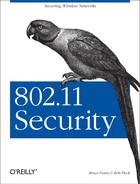From the early days of wireless communication, the ability to transmit news, thoughts, and feelings without wires has revolutionized our daily lives. The radio broadcasts of the 1920s brought instant news and entertainment to households all over the world. The adoption of television in the 1950s added a visual aspect to the experience. CB radio made a big impact in the 1970s, allowing individuals within a limited distance to talk with each other while on the road. In the 1980s, cellular phones and pagers allowed people to be connected to their home or office no matter where they were. Now at the start of the 21st century, low-cost, high-speed wireless data networking has become a reality. Anyone can go to his or her local computer store and easily purchase wireless networking equipment that can transmit packet-based data at millions of bits per second.
Throughout the entire process, the integrity and confidentiality of the information traveling through the air has always been a concern. Who is really broadcasting the signal you are receiving? Is anyone eavesdropping on the signal? How can you make sure that an eavesdropper is unable to obtain useful information from the signal? These questions are not particularly important when you are watching television but become critical when you are transmitting data between military installations or making a stock transaction over the Internet using your 802.11b-capable PDA. Due to the ease with which an attacker can intercept or modify your 802.11b communications, it is imperative that you understand the risks in using a wireless network and how to protect yourself, your infrastructure, and your users.
This book is aimed at network engineers, security engineers, systems administrators, or general hobbyists interested in deploying secure 802.11b-based systems. Primarily, the discussions in this book revolve around Linux and FreeBSD. However, there is a great deal of general-purpose information as well as tips and techniques for Windows users and users of firmware-based wireless access points.
The book assumes the reader is familiar with the installation and maintenance of Linux or FreeBSD systems. The techniques in the book rely heavily on custom kernel configuration, startup scripts, and general knowledge of how to configure the operating systems. We provide links and references to resources to help with these issues but do not address then directly. This book concentrates on the issues germane to wireless security and leaves the operating-system-specific installation procedures as an exercise to the user.
The reader is also assumed to be familiar with general networking concepts. The reader should understand, at least at a high level, concepts such as the OSI layers, IP addressing, route tables, ARP, and well-known ports. We feel this makes the book more readable and useful as a guide for wireless networks, not networks in general. Again, we attempt to provide references to other resources to assist readers who may be unfamiliar with these topics.
